"Ford class" redirects here. For the 1950s Royal Navy vessels, see Ford-class seaward defence boat.
 USS Gerald R. Ford underway in April 2017 USS Gerald R. Ford underway in April 2017 | |
| Class overview | |
|---|---|
| Name | Gerald R. Ford-class aircraft carrier |
| Builders | Newport News Shipbuilding |
| Operators | |
| Preceded by | |
| Cost |
|
| In service | 2017–present |
| Planned | 10 |
| On order | 2 |
| Building | 2 |
| Completed | 1 |
| Active | 1 |
| General characteristics | |
| Type | Aircraft carrier |
| Displacement | About 100,000 long tons (100,000 tonnes) (full load) |
| Length | 1,092 ft (333 m) – 1,106 ft (337 m) |
| Beam |
|
| Height | 250 feet (76 m) |
| Draft | 39 ft (12 m) |
| Decks | 25 |
| Installed power | Two Bechtel A1B PWR nuclear reactors, HEU 93.5% |
| Propulsion | Four shafts |
| Speed | In excess of 30 knots (56 km/h; 35 mph) |
| Range | Unlimited |
| Endurance | 50-year service life |
| Complement |
|
| Crew | About 2,600 |
| Sensors and processing systems |
|
| Electronic warfare & decoys |
|
| Armament |
|
| Aircraft carried | 75+ |
| Aviation facilities | 1,092 ft × 252 ft (333 m × 77 m) flight deck |
The Gerald R. Ford-class nuclear-powered aircraft carriers are currently being constructed for the United States Navy, which intends to eventually acquire ten of these ships in order to replace current carriers on a one-for-one basis, starting with the lead ship of her class, Gerald R. Ford (CVN-78), replacing Enterprise (CVN-65), and later the Nimitz-class carriers. The new vessels have a hull similar to the Nimitz class, but they carry technologies since developed with the CVN(X)/CVN-21 program, such as the Electromagnetic Aircraft Launch System (EMALS), as well as other design features intended to improve efficiency and reduce operating costs, including sailing with smaller crews. This class of aircraft carriers is named after former U.S. President Gerald R. Ford. CVN-78 was procured in 2008 and commissioned into service in July 2017. The second ship of the class, John F. Kennedy (CVN-79), is scheduled to enter service in 2025.
Design features
Carriers of the Gerald R. Ford class have:
- Advanced Arresting Gear.
- Automation, allowing a crew of several hundred fewer than the Nimitz-class carrier.
- The updated RIM-162 Evolved SeaSparrow Missile.
- An AN/SPY-3 X Band multifunction radar and an AN/SPY-4 S Band volume search radar. Designated together as Dual Band Radar (DBR), initially developed for the Zumwalt-class destroyers. Starting with John F. Kennedy (CVN-79), the AN/SPY-6 will replace the AN/SPY-4 as the volume search component of the system.
- An Electromagnetic Aircraft Launch System (EMALS) in place of traditional steam catapults for launching aircraft.
- A new nuclear reactor design (the A1B reactor) for greater power generation.
- Stealth features to reduce radar cross-section.
- The ability to carry up to 90 aircraft, including the Boeing F/A-18E/F Super Hornet, Boeing EA-18G Growler, Grumman C-2 Greyhound, Northrop Grumman E-2 Hawkeye, Lockheed Martin F-35C Lightning II, Sikorsky SH-60 Seahawk helicopters, and unmanned combat aerial vehicles.
The biggest visible difference from earlier supercarriers is the more aft location of the island (superstructure). The Gerald R. Ford-class carriers will have a reduced whole-life cost due in part to reduced crew size. These ships are intended to sustain 160 sorties per day for 30-plus days, with a surge capability of 270 sorties per day. Director of Operational Testing Michael Gilmore has criticized the assumptions used in these forecasts as unrealistic and has indicated sortie rates similar to the 120/240 per day of the Nimitz class would be acceptable.
Development

The current Nimitz-class aircraft carriers in US naval service have been part of United States power projection strategy since Nimitz was commissioned in 1975. Displacing about 100,000 tons when fully loaded, a Nimitz-class carrier can steam in excess of 30 knots (56 km/h; 35 mph), cruise without resupply for 90 days, and launch aircraft to strike targets hundreds of miles away. The endurance of the Nimitz class is exemplified by USS Theodore Roosevelt, which spent 159 days underway during Operation Enduring Freedom without visiting a port or being refueled.
The Nimitz design has accommodated many new technologies over the decades, but it has limited ability to support the most recent technical advances. As a 2005 Rand report said, "The biggest problems facing the Nimitz class are the limited electrical power generation capability and the upgrade-driven increase in ship weight and erosion of the center-of-gravity margin needed to maintain ship stability."
With these constraints in mind, the US Navy developed what was initially known as the CVN-21 program, which evolved into CVN-78, Gerald R. Ford. Improvements were made through developing technologies and more efficient design. Major design changes include a larger flight deck, improvements in weapons and material handling, a new propulsion plant design that requires fewer people to operate and maintain, and a new, smaller island that has been pushed aft. Technological advances in electromagnetics have led to the development of an Electromagnetic Aircraft Launch System (EMALS) and an Advanced Arresting Gear (AAG). An integrated warfare system, the Ship Self-Defense System (SSDS), has been developed to allow the ship to more easily take on new missions. The new Dual Band Radar (DBR) combines S-band and X-band radar.
These advances will allow the new Gerald R. Ford-class carriers to launch 25% more sorties, generate triple the electrical power with improved efficiency, and offer crew quality-of-life improvements.
Flight deck
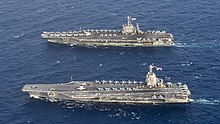
Catapult No. 4 on the Nimitz class cannot launch fully loaded aircraft because of low wing clearance along the edge of the flight deck.
The movement of weapons from storage and assembly to the aircraft on the flight deck has also been streamlined and accelerated. Ordnance will be lifted to the centralized rearming location via higher-capacity weapons elevators that use linear motors. These elevators are located so that ordnance need not cross any areas of aircraft movement, thereby reducing traffic problems in the hangars and on the flight deck. In 2008, Rear Admiral Dennis M. Dwyer said these changes will make it hypothetically possible to rearm the airplanes in "minutes instead of hours".
Power generation
The new Bechtel A1B reactor for the Gerald R. Ford class is smaller and simpler, requires fewer crew, and yet is far more powerful than the Nimitz-class A4W reactor. Two reactors will be installed on each Gerald R. Ford-class carrier, providing a power generation capacity at least 25% greater than the 550 MW (thermal) of the two A4W reactors in a Nimitz-class carrier. The portion of thermal power allotted to electrical generation will be tripled.
The propulsion and power plant of the Nimitz-class carriers were designed in the 1960s, when onboard technologies required less electrical power. "New technologies added to the Nimitz-class ships have generated increased demands for electricity; the current base load leaves little margin to meet expanding demands for power."
The Gerald R. Ford-class ships convert steam into power by piping it to four main turbine generators (MTG) to generate electricity for major ship systems, and the new electromagnetic catapults. The Gerald R. Ford-class ships use steam turbines for propulsion.
A larger power output is a major component of the integrated warfare system. Engineers took extra steps to ensure that integrating unforeseen technological advances onto a Gerald R. Ford-class aircraft carrier would be possible. The Navy expects the Gerald R. Ford class will be part of the fleet for 90 years, until the year 2105, which means that the class must successfully accept new technology over the decades. Only half of the electric power generation capacity is used by currently planned systems, with half remaining available for future technologies.
Electromagnetic Aircraft Launch System
Main article: Electromagnetic Aircraft Launch System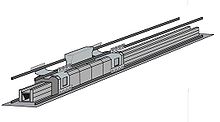
The Electromagnetic Aircraft Launch System (EMALS) launches aircraft by means of a catapult employing a linear induction motor rather than the steam piston used on the Nimitz class. The EMALS accelerates aircraft more smoothly, putting less stress on their airframes. The EMALS also weighs less, is expected to cost less and require less maintenance, and can launch both heavier and lighter aircraft than a steam piston-driven system. It also reduces the carrier's requirement for fresh water, thus reducing the demand for energy-intensive desalination.
Advanced Arresting Gear landing system
Main article: Advanced Arresting Gear| This section needs additional citations for verification. Please help improve this article by adding citations to reliable sources in this section. Unsourced material may be challenged and removed. (January 2021) (Learn how and when to remove this message) |
Electromagnets are also being used in the new Advanced Arresting Gear (AAG) system. The current system relies on hydraulics to slow and stop a landing aircraft. While the hydraulic system is effective, as demonstrated by more than fifty years of implementation, the AAG system offers a number of improvements. The current system is unable to capture unmanned aerial vehicles (UAVs) without damaging them due to extreme stresses on the airframe. UAVs do not have the necessary mass to drive the large hydraulic piston used to trap heavier, manned airplanes. By using electromagnetics, the energy absorption is controlled by a turbo-electric engine. This makes the trap smoother and reduces shock on airframes. Even though the system will look the same from the flight deck as its predecessor, it will be more flexible, safe, and reliable, and will require less maintenance and manning.
Sensors and self-defense systems
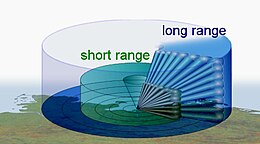 Diagram of AN/SPY-3 vertical electronic pencil beam radar conex projections
Diagram of AN/SPY-3 vertical electronic pencil beam radar conex projections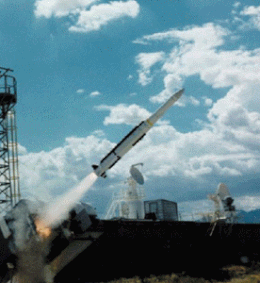 An Evolved SeaSparrow Missile launching
An Evolved SeaSparrow Missile launching
Another addition to the Gerald R. Ford class is an integrated active electronically scanned array search and tracking radar system. The dual-band radar (DBR) was being developed by Raytheon, for both the Zumwalt-class guided missile destroyers and the Gerald R. Ford-class aircraft carriers. The island can be kept smaller by replacing six to ten radar antennas with a single six-faced radar. The DBR works by combining the X band AN/SPY-3 multifunction radar with the S band AN/SPY-4 Volume Search Radar (VSR) emitters, distributed into three phased arrays. The S-band radar was later deleted from the Zumwalt-class destroyers to save money.
The three faces dedicated to the X-band radar handle low-altitude tracking and radar illumination, while the three S-band faces handle target search and tracking regardless of weather. "Operating simultaneously over two electromagnetic frequency ranges, the DBR marks the first time this functionality has been achieved using two frequencies coordinated by a single resource manager."
This new system has no moving parts, therefore minimizing maintenance and manning requirements for operation. The AN/SPY-3 consists of three active arrays and the Receiver/Exciter (REX) cabinets above-decks and the Signal and Data Processor (SDP) subsystem below-decks. The VSR has a similar architecture, with the beamforming and narrowband down-conversion functionality occurring in two additional cabinets per array. A central controller (the resource manager) resides in the Data Processor (DP). The DBR is the first radar system that uses a central controller and two active-array radars operating at different frequencies. The DBR gets its power from the Common Array Power System (CAPS), which comprises Power Conversion Units (PCUs) and Power Distribution Units (PDUs). The DBR is cooled via a closed-loop cooling system called the Common Array Cooling System (CACS).
The Enterprise Air Surveillance Radar (EASR) is a new design surveillance radar that is to be installed in the second Gerald R. Ford-class aircraft carrier, John F. Kennedy (CVN-79), in lieu of the Dual Band radar. The America-class amphibious assault ships starting with LHA-8 and the planned LX(R) will also have this radar. The EASR suite's initial per-unit cost will be about $180 million less than the DBR, for which the estimate is about $500 million.
Possible upgrades
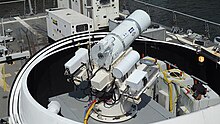
Future defense systems, such as free-electron laser directed-energy weapons, electric armor, and tracking systems will require more power. "Only half of the electrical power-generation capability on CVN-78 is needed to run currently planned systems, including EMALS. CVN-78 will thus have the power reserves that the Nimitz class lacks to run lasers and electric armor." The addition of new technologies, power systems, design layout, and better control systems results in an increased sortie rate of 25% over the Nimitz class and a 25% reduction in manpower required to operate.
Waste management technology will be deployed on Gerald R. Ford. Co-developed with the Carderock Division of the Naval Surface Warfare Center, PyroGenesis Canada Inc. - was in 2008 awarded the contract to outfit the ship with a Plasma Arc Waste Destruction System (PAWDS). This compact system will treat all combustible solid waste generated on board the ship. After having completed factory acceptance testing in Montreal, the system was scheduled to be shipped to the Huntington Ingalls shipyard in late 2011 for installation on the carrier.
The Navy is developing a free-electron laser (FEL) to defend against cruise missiles and small-boat swarms.
3D computer-aided design
Newport News Shipbuilding used a full-scale three-dimensional product model developed in Dassault Systèmes CATIA V5 to design and plan the construction of the Gerald R. Ford class of aircraft carriers.
The CVN 78 class was designed to have better weapons movement paths, largely eliminating horizontal movements within the ship. Current plans call for advanced weapons elevators to move from storage areas to dedicated weapons handling areas. Sailors would use motorized carts to move the weapons from storage to the elevators at different levels of the weapons magazines. Linear motors are being considered for the advanced weapons elevators. The elevators will also be relocated such that they will not impede aircraft operations on the flight deck. The redesign of the weapons movement paths and the location of the weapons elevators on the flight deck will reduce manpower and contribute to a much higher sortie generation rate.
Crew accommodations

Systems that reduce crew workload have allowed the ship's company on Gerald R. Ford-class carriers to total only 2,600 sailors, about 700 fewer than a Nimitz-class carrier. The massive, 180-man berthing areas on the Nimitz class are replaced by 40-rack berthing areas on Gerald R. Ford-class carriers. The smaller berthings are quieter and the layout requires less foot traffic through other spaces. Typically the racks are stacked three high, with locker space per person. The berthings do not feature modern "sit-up" racks with more headroom; bottom and middle racks only accommodate a sailor lying down. Each berthing has an associated head, including showers, vacuum-powered septic-system toilets (no urinals since the berthings are built gender-neutral) and sinks to reduce travel and traffic to access those facilities. WiFi-enabled lounges are located across the passageway in separate spaces from the berthing's racks.
Since deployment, the first two carriers of the class have run into problems with the plumbing of the waste system. The pipes were too narrow to handle the load of users, resulting in the vacuum failing and repeatedly clogged toilets. To alleviate the problem, specialized acidic cleaning solutions have been used to flush out the sewage system. These cleaning treatments cost about $400,000 each time, resulting in a substantial unplanned increase in the lifetime expense of operating these ships according to the GAO. These cleanings will have to be performed for the lifetime of the ship.
Medical facilities
Gerald R. Ford, first in the class, has an on-board hospital that includes a full laboratory, pharmacy, operating room, 3-bed intensive care unit, 2-bed emergency room, and 41-bed hospital ward, staffed by 11 medical officers and 30 hospital corpsmen.
Construction

Construction of the first vessel in the class, CVN-78 Gerald R. Ford, officially began on 11 August 2005, when Northrop Grumman held a ceremonial steel cut for a 15-ton plate that would form part of a side shell unit of the carrier, but construction began in earnest in early 2007. The carrier was assembled at Newport News Shipbuilding, a division of Huntington Ingalls Industries (formerly Northrop Grumman Shipbuilding) in Newport News, Virginia. This is the only shipyard in the United States that can build nuclear-powered aircraft carriers.
In 2005, Gerald R. Ford was estimated to cost at least $13 billion: $5 billion for research and development plus $8 billion to build. A 2009 report raised the estimate to $14 billion, including $9 billion for construction. In 2013, the life-cycle cost per operating day of a carrier strike group (including aircraft) was estimated at $6.5 million by the Center for New American Security.
Originally, a total of three carriers were authorized for construction, but if the Nimitz-class carriers and Enterprise were to be replaced one-for-one, 11 carriers would be required over the life of the program. The last Nimitz-class aircraft carrier is to be decommissioned in 2058.
In a speech on 6 April 2009, Secretary of Defense Robert Gates announced that each Gerald R. Ford-class carrier would be built over five years, yielding a "more fiscally sustainable path" and a 10-carrier fleet after 2040. That changed in December 2016, when Navy Secretary Ray Mabus signed a Force Structure Assessment calling for a 355-ship fleet with 12 aircraft carriers. If enacted, this policy would require each Gerald R. Ford-class carrier to be built in three to four years.
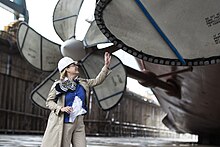
First-of-class type design changes
As construction of CVN-78 progressed, the shipbuilder made first-of-class type design changes, which it will use to update the model before the construction of the remaining vessels of its class. Several of these design changes related to EMALS configuration changes, which required electrical, wiring, and other changes within the ship. The Navy anticipates additional design changes stemming from remaining advanced arresting gear development and testing. According to the Navy, many of these 19,000 changes were programmed into the construction schedule early on—a result of the government's decision, at contract award, to introduce improvements to the ship's warfare systems during construction, which are heavily dependent on evolving commercial technologies.
Naming
There was a movement by the USS America Carrier Veterans' Association to have CVN-78 named after America rather than after President Ford. Eventually, the amphibious assault ship LHA-6 was named America.
On 27 May 2011, the U.S. Department of Defense announced the name of CVN-79 would be USS John F. Kennedy.
On 1 December 2012, Secretary of the Navy Ray Mabus announced that CVN-80 would be named USS Enterprise. The information was delivered during a prerecorded speech as part of the deactivation ceremony for the previous Enterprise (CVN-65). The future Enterprise (CVN-80) will be the ninth U.S. Navy ship to bear this name.
On 20 January 2020, during a ceremony in Pearl Harbor, Hawaii, on Martin Luther King Jr. Day, Acting Secretary of the Navy Thomas B. Modly named a future Gerald R. Ford-class aircraft carrier in honor of World War II hero Doris Miller. This will be the first aircraft carrier named for an African American, and the first aircraft carrier to be named for a sailor in the enlisted ranks. It is the second ship named in honor of Miller, who was the first African American to be awarded the Navy Cross.
On 13 January 2025, President Joe Biden announced that CVN-82 and CVN-83 would be named after former Presidents Bill Clinton and George W. Bush respectively.
Ships in class
There are expected to be ten ships of this class. To date, six have been announced:
| Ship | Hull no. | Laid down | Launched | Commissioned | Status | Scheduled to replace | References |
|---|---|---|---|---|---|---|---|
| Gerald R. Ford | CVN-78 | 13 November 2009 | 11 October 2013 | 22 July 2017 | Active, in service | Enterprise (CVN-65) | |
| John F. Kennedy | CVN-79 | 22 August 2015 | 29 October 2019 | 2025 (scheduled) | Fitting out | Nimitz (CVN-68) | |
| Enterprise | CVN-80 | 5 April 2022 | November 2025 (scheduled) | 2029 (scheduled) | Under construction | Dwight D. Eisenhower (CVN-69) | |
| Doris Miller | CVN-81 | January 2026 (scheduled) | October 2029 (scheduled) | 2032 (scheduled) | Under construction | Carl Vinson (CVN-70) | |
| William J. Clinton | CVN-82 | 2027 (scheduled) | 2032 (scheduled) | 2036 (scheduled) | Planned | Theodore Roosevelt (CVN-71) | |
| George W. Bush | CVN-83 | TBD | TBD | TBD | Planned | TBD |
See also
- Modern United States Navy carrier air operations
- List of aircraft carriers
- List of naval ship classes in service
- List of current United States Navy ships
- List of aircraft carrier classes of the United States Navy
- A1B reactor
- Naval aviation
- Type 003 aircraft carrier (China)
- Queen Elizabeth-class aircraft carrier (United Kingdom)
- PANG (France)
Notes
- Before its redesignation to Gerald R. Ford class, the new carrier (CVN-78) was known as the CVN(X) carrier program ("X" meaning "in development") and then as the CVN-21 carrier program. (Here, "21" is not a hull number, but rather it is common in future plans of the US military, alluding to the 21st century.)
References
- ^ O'Rourke, Ronald (22 December 2017). "Navy Ford (CVN-78) Class Aircraft Carrier Program: Background and Issues for Congress" (PDF). Congressional Research Service. Archived (PDF) from the original on 28 December 2017. Retrieved 16 January 2018.
- Combat fleet of the world 2012
- Keller, John (8 June 2015). "Navy awards $3.4 billion contract to Huntington Ingalls to build Ford-class aircraft carrier". Military Aerospace Electronics Magazine. Archived from the original on 17 November 2015. Retrieved 28 October 2015.
- "Aircraft Carriers - CVN". Fact File. United States Navy. 17 September 2020. Retrieved 18 November 2020.
- ^ "Aircraft Carriers - CVN". Fact Files. U.S. Navy Office of Information. 17 September 2020. Retrieved 18 November 2020.
- "Command History & Facts". Commander, Naval Air Force Atlantic. US Navy. Retrieved 8 March 2021.
- ^ "Aircraft Carriers – CVN". navy.mil. Department of the Navy. 16 October 2014. Archived from the original on 17 October 2013. Retrieved 19 July 2022.
- McFadden, Christopher (24 June 2022). "USS Gerald R. Ford: The most advanced carrier of the US cost around $13.3 billion to build". Interesting Engineering. Retrieved 7 July 2022.
- ^ "USS Gerald R. Ford (CVN 78)". U.S. Carriers. US Navy. Archived from the original on 28 March 2014. Retrieved 1 December 2012.
- "US study of reactor and fuel types to enable naval reactors to shift from HEU fuel". fissilematerials.org. 10 April 2020. Retrieved 5 November 2022.
- "Validation of the Use of Low Enriched Uranium as a Replacement for Highly Enriched Uranium in US Submarine Reactors" (PDF). dspace.mit.edu. 19 May 2015. Retrieved 5 November 2022.
- Jenkins, Aric (22 July 2017). "The USS Gerald Ford Is the Most Advanced Aircraft Carrier in the World". Fortune. Archived from the original on 23 July 2017. Retrieved 23 July 2017.
- "FY 2022 Annual Report" (PDF). Director, Operational Test and Evaluation. p. 167. Retrieved 19 June 2023.
- Zulkifli, Muhammad; Muhammad, Fadli; Nurjanah (2021). "Strengthening Indonesia Naval Base as a Aircraft Carrier at the Frontier to Increase Power of Deterrence and State Defense at Sea" (PDF). Journal of Defense Resources Management. 12 (2): 252.
- ^ "CVN 78 Gerald R Ford Class". Naval technology.com. 22 December 2009. Archived from the original on 20 December 2013. Retrieved 26 March 2010.
- McLaughlin, Elizabeth (2 March 2017). "The USS Gerald R. Ford: By the numbers". ABC News. Archived from the original on 12 November 2020. Retrieved 26 January 2022.
- ^ Sweetman, Bill (1 June 2010). "Carrier Launch System Passes Initial Tests". Aviation Week. Archived from the original on 15 August 2017. Retrieved 14 August 2017.
- ^ "Costing the CVN-21: A DID Primer". Defense Industry Daily. 19 December 2005. Archived from the original on 12 June 2007. Retrieved 7 November 2007. Covers the costs of the CVN-21 program, how those are calculated, and where the $5 billion savings on operational costs is expected to come from over the ship's planned 50-year lifetime.
- "Gerald R. Ford-class Nuclear-Powered Aircraft Carriers, US". Naval Technology. Retrieved 30 October 2024.
- ^ "Gerald R Ford Class (CVN 78/79) – US Navy CVN 21 Future Carrier Programme – Naval Technology". naval-technology.com. Archived from the original on 20 December 2013. Retrieved 1 April 2015.
- "AN/SPY-4 Volume Search Radar". GlobalSecurity.org. Archived from the original on 11 August 2017. Retrieved 10 August 2017.
- ^ O'Rourke, Ronald (31 May 2017). "Navy DDG-51 and DDG-1000 Destroyer Programs: Background and Issues for Congress" (PDF). Congressional Research Service. Archived (PDF) from the original on 28 March 2015. Retrieved 4 April 2015.
- "Raytheon Awarded $92M Navy Contract for Future Carrier Radars". 22 August 2016.
- "US Navy selects builder for new MQ-25 Stingray aerial refueling drone". DefenseNews. 31 August 2018.
- "Aircraft Carriers – CVN 21 Program" (PDF). US Navy (Navy Fact File). 9 February 2011. Archived from the original (PDF) on 22 July 2011. Retrieved 9 February 2011.
- Keeter, Hunter (June 2003). "New Carrier Island Is at Heart of Higher Sortie Rates for CVN 21". NavyLeague.org. Archived from the original on 27 September 2011. Retrieved 21 August 2011.
- "Head of the Class". Naval Aviation News. 22 December 2015. Archived from the original on 16 February 2016. Retrieved 15 February 2016.
- ^ FY2013 Annual Report for the Office of the Director, Operational Test & Evaluation – CVN-78 Gerald R. Ford Class Nuclear Aircraft Carrier (PDF), Director, Operational Test & Evaluation, archived from the original (PDF) on 25 May 2014, retrieved 8 February 2014
- Tony Capaccio (10 January 2014). "Hagel Told New Carrier Unlikely to Meet Aircraft Goals". Bloomberg. Archived from the original on 29 December 2016. Retrieved 28 December 2016.
- "Ship Information". USS Nimitz Homepage. 4 March 2008.
- "Our Ship". USS Theodore Roosevelt (CVN 71) Web Page. 4 March 2008.
- Schank, John. Modernizing the U.S. Aircraft Carrier Fleet: Accelerating CVN 21 Production Versus Mid-Life Refueling. Santa Monica: Rand Corporation, 2005. p. 76.
- ^ Larrabee, Chuck. DDG 1000 Dual Band Radar (DBR). Raytheon. 1 March 2008.
- Schank, John. Modernizing the U.S. Aircraft Carrier Fleet, p. 77.
- "Advanced Weapons Elevators". Federal Equipment Co. Archived from the original on 22 February 2013. Retrieved 1 April 2015.
- Keeter, Hunter. "New carrier island is a heart of higher sortie rates for CVN 21". BNET Business Management Network. 4 March 2008.
- "Nuclear-Powered Ships". world-nuclear.org. Archived from the original on 12 June 2013. Retrieved 1 April 2015.
- Ragheb, M. (18 June 2017). "Nuclear Marine Propulsion" (PDF). mregheb.com. Archived (PDF) from the original on 12 August 2014. Retrieved 29 October 2014.
- Schank, John; Smith, Giles; Alkire, Brien; Arena, Mark V. (2005). "Modernizing the U.S. Aircraft Carrier Fleet: Accelerating CVN 21 Production Versus Mid-Life Refueling" (PDF). Rand. Archived (PDF) from the original on 20 October 2014. Retrieved 25 August 2017.
- "Gerald Ford Carrier Problems". 27 March 2019. Archived from the original on 6 July 2019. Retrieved 6 July 2019.
- ^ "How Not to Build a Ship: The USS Ford". Project on Government Oversight. 30 May 2017. Retrieved 1 January 2020.
- ^ Schank, John. Modernizing the U.S. Aircraft Carrier Fleet p. 83.
- "Electromagnetic Aircraft Launch System (EMALS)". Navair.
- Rodriguez, Carmelo. "Launch and Recovery Testing". ITEA-SAN. Turboelectric Arresting Gear. Mission Valley Hotel, San Diego. 16 June 2005.
- Larrabee, Chuck. "Raytheon Successfully Integrates Final Element of Dual Band Radar for DDG 1000 Zumwalt Class Destroyer". Raytheon News Release. 4 March 2008.
- Tolley, Alan L.; Ball, John E. "Dual-Band Radar Development: From Engineering Design to Production" (PDF). NAVSEA Warfare Center. Archived from the original (PDF) on 12 December 2014. Retrieved 28 October 2014.
- "Navy C4ISR and Unmanned Systems". Sea Power 2016 Almanac. Navy League of the U.S. January 2016. p. 91. Archived from the original on 28 January 2017. Retrieved 9 November 2016.
- "Enterprise Air Surveillance Radar (EASR)" (PDF). Aerospace Daily & Defense Report. Aviation Week Network. 24 August 2014. Archived (PDF) from the original on 7 October 2016. Retrieved 7 March 2016.
- Taylor, Leslie (7 June 2006), CVN21 MS&A Overview, NDIA
{{citation}}: CS1 maint: location missing publisher (link). - The Plasma Arc Waste Destruction System to Reduce Waste Aboard CVN-78 (PDF), Seaframe – Carderock Division Publication, 2008, p. 13, archived from the original on 1 December 2012, retrieved 1 December 2012
- Wang, Brian (4 March 2016). "US Navy plans for scaling Free electron lasers to megawatt weapon systems". Next Big Future. Archived from the original on 9 August 2017. Retrieved 9 August 2017.
- Ackerman, Spencer (18 February 2011). "Unexpectedly, Navy's superlaser blasts away a record". Wired. Archived from the original on 30 January 2017. Retrieved 7 March 2017..
- O'Rourke, Ronald (12 June 2015). "Navy Shipboard Lasers for Surface, Air, and Missile Defense: Background and Issues for Congress" (PDF). Congressional Research Service. Archived (PDF) from the original on 28 March 2015. Retrieved 4 April 2015..
- "MODERNIZING THE U.S. AIRCRAFT CARRIER FLEET – Accelerating CVN 21 Production Versus Mid-Life Refueling" (PDF). National Defense Research Institute. RAND Corporation. Archived (PDF) from the original on 20 October 2014. Retrieved 17 March 2015.
- ^ Bacon, Lance M. (13 October 2014). "Crew's ship: Sailors' comfort a centerpiece of new supercarrier Ford". Navy Times. Retrieved 5 June 2017.
- Shapiro, Michael Welles (25 June 2012). "No urinals on the Ford-class carriers". Newport News Daily Press. Archived from the original on 7 April 2017. Retrieved 6 April 2017.
- ^ Capaccio, Anthony (24 March 2020). "Unclogging Toilets at $400,000 a Flush Hits Navy's Costs". Bloomberg. Retrieved 30 December 2020.
- "Meet Gerald R. Ford's Senior Medical Officer". ussgeraldrford.wordpress.com. 8 August 2016. Archived from the original on 5 January 2018. Retrieved 5 January 2018.
- "Ford Reaches 50 Percent Structural Completion" (PDF). Newport News Shipbuilding. Archived (PDF) from the original on 28 October 2014. Retrieved 1 September 2011.
- Glass, Jon W. (25 March 2007). "Construction Begins on the First Ford-class Carrier". The Virginian-Pilot. Retrieved 31 October 2008.
- "The Politician Class Carriers Evolve". strategypage.com. 12 April 2009. Archived from the original on 15 April 2009. Retrieved 18 April 2009.
- Capt Henry J. Hendrix, USN (PhD) (March 2009). "At What Cost a Carrier?" (PDF). Disruptive Defense Papers. Center for a New American Security. Archived from the original (PDF) on 13 August 2014.
- "Defense Budget Recommendation Statement (Arlington, VA)". US Department of Defense. 6 April 2009. Archived from the original on 3 December 2009. Retrieved 27 March 2010.
- Navy, This story was written by The Office of the Secretary of the. "Secretary of the Navy Announces Need for 355-ship Navy". Archived from the original on 7 April 2018. Retrieved 6 April 2018.
- "Navy Wants 355 Ships; New Assessment Adds Destroyers, Attack Subs". 16 December 2016. Archived from the original on 7 April 2018. Retrieved 6 April 2018.
- "Report to Congress on Gerald R. Ford Class Carrier Program - USNI News". 4 April 2018. Archived from the original on 7 April 2018. Retrieved 6 April 2018.
- "FORD - CLASS CARRIERS: Lead Ship Testing and Reliability Shortfalls Will Limit Initial Fleet Capabilities" (PDF). GAO. September 2013. Archived (PDF) from the original on 27 September 2014. Retrieved 24 October 2014.
- LaGrone, Sam (23 April 2013). "Twenty Six US Navy Ship Naming Controversies" (USS Gerald R. Ford). USNI News. U.S. Naval Institute. Archived from the original on 13 August 2017. Retrieved 12 August 2017.
The vets argued that Ford was not much more than an adequate president, so it was more fitting for the carrier-class to be known as America...
- "Navy Names Next Aircraft Carrier USS John F. Kennedy". U.S. Department of Defense. Archived from the original (News Release) on 20 August 2013. Retrieved 29 May 2011.
- "US Navy's Ford-class aircraft carrier to be named Enterprise". Brahmand.com. 4 December 2012. Archived from the original (Defence & Aerospace News) on 7 December 2012. Retrieved 4 December 2012.
- Diaz, Johnny (18 January 2020). "Navy Aircraft Carrier to Be Named for Black Pearl Harbor Veteran". The New York Times. Retrieved 19 January 2020.
- Acting Secretary of the Navy Public Affairs (19 January 2020). "Navy Will Name A Future Ford Class Aircraft Carrier After WWII Hero Doris Miller" (Press release). United States Navy.
- ^ LaGrone, Sam (18 January 2020). "Next Ford-class Carrier to be Named After Pearl Harbor Hero Doris Miller". USNI News. Retrieved 18 January 2020.
- ^ Collette, Christopher (13 January 2025). "Future US aircraft carriers to bear Clinton and Bush names". WVEC. Retrieved 13 January 2025.
- "CVN-77 Delivery Moved To December, Newport News on Track For January Commissioning". Defense Daily. 4 August 2008. Archived from the original on 13 August 2017. Retrieved 12 August 2017.
- "The US Navy just took delivery of the world's most advanced aircraft carrier". Business Insider. Archived from the original on 1 June 2017. Retrieved 1 June 2017.
- "Aircraft Carrier Gerald R. Ford (CVN 78) Christened at Newport News Shipbuilding". Defence Talk. 12 November 2013. Archived from the original on 3 December 2013. Retrieved 2 December 2013.
- Ress, Dave (3 November 2020). "To speed up delivery of USS John F. Kennedy, Navy to pay up to $315 million extra". dailypress.com. Retrieved 16 January 2021.
- LaGrone, Sam (5 April 2022). "HII Lays Keel of Future Aircraft Carrier USS Enterprise". usni.org. U.S. Naval Institute.
- ^ Malone, Capt. Phillip (May 6, 2019). "Sea Air Space Exposition: John F. Kennedy (CVN 79) Enterprise (CVN 80) & Unnamed (CVN 81) – Two Ship Buy" (PDF). Naval Sea Systems Command.
- Shelbourne, Mallory (15 March 2024). "Aircraft Carrier Enterprise Delivery Delayed by 18 Months, Says Navy". usni.org. U.S. Naval Institute.
- "First cut of steel kicks off construction of the aircraft carrier Enterprise at Newport News Shipbuilding" (Press release). WTKR. 21 August 2017. Archived from the original on 15 September 2017. Retrieved 6 September 2017.
External links
- Aircraft Carriers – CVN – US Navy Fact File
- Building The Ford Class Aircraft Carriers - Newport News Shipbuilding
- Design & Preparations Continue for the USA's New CVN-21 Super-Carrier (updated), Defense Industry Daily. Provides an extensive briefing re: the new ship class, and adds entries for many of the contracts under this program.
- Gerald R. Ford Class (CVN-78) Aircraft Carrier on Navy Recognition site Archived 23 March 2016 at the Wayback Machine
- GAO Reports: Poor Outcomes Are the Predictable Consequences of the Prevalent Acquisition Culture (October 2015), Follow-On Ships Need More Frequent and Accurate Cost Estimates to Avoid Pitfalls of Lead Ship (June 2017)
| Gerald R. Ford-class aircraft carriers | |
|---|---|
| |
| Active ship classes of the United States Navy | |||||||||||||
|---|---|---|---|---|---|---|---|---|---|---|---|---|---|
| Commissioned |
| ||||||||||||
| Military Sealift Command |
| ||||||||||||
| |||||||||||||
| Aircraft carrier classes in service | |
|---|---|
| CATOBAR | |
| STOBAR | |
| STOVL | |